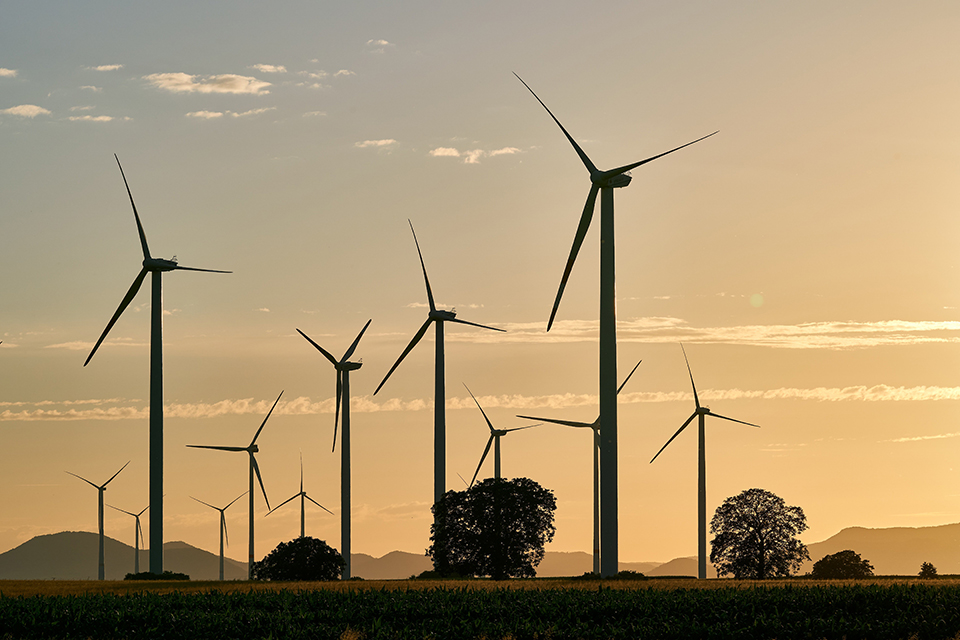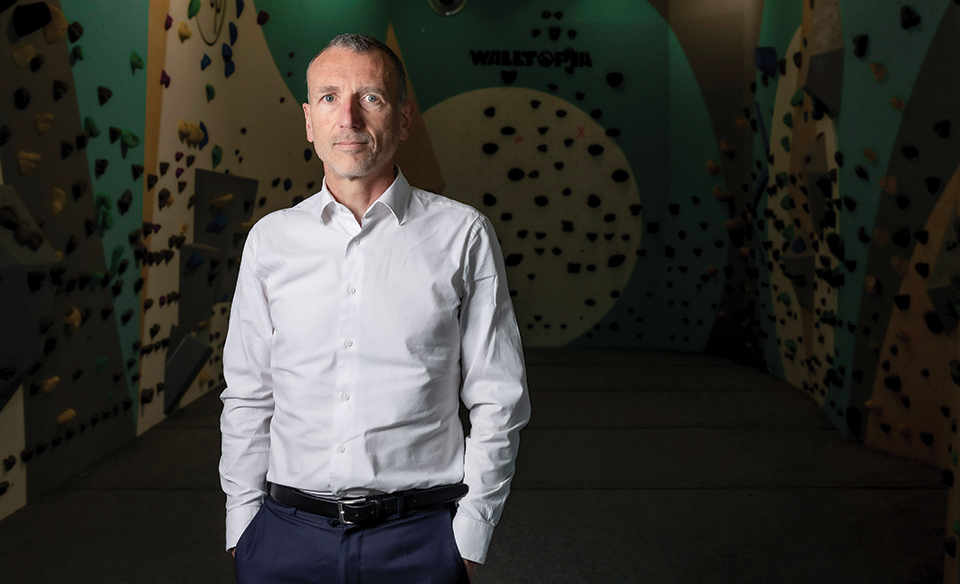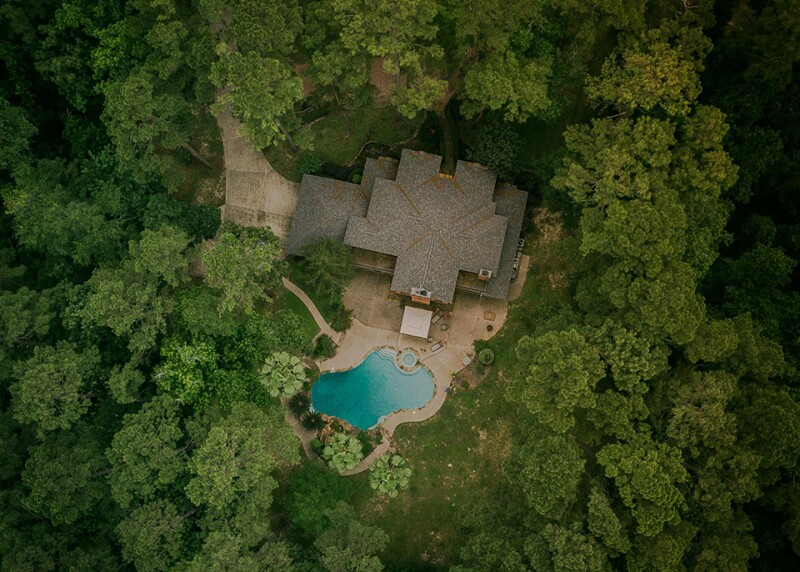COP26: Latest
Marisa Drew is reacquainting herself with Credit Suisse’s offices on London’s Pall Mall when we speak.
It has been nearly two years since she set foot in a building that insiders call the ‘happy place’ due to its central location (a stone’s throw from St James’s Park and Regent Street) in a part of the city that everyone loves to visit.
Digital networks were upgraded or replaced during the long Covid-enforced absence, so even simple stuff like finding out the new internet password can be a challenge.
Not that it seems to daunt her.
She laughs at the Wi-Fi snafu. In fact, she laughs a lot. Not just for someone in banking – an industry not known for attracting naturally jovial types – but in any walk of life.
Part of that is innate. She describes herself as both an “eternal optimist” and a “massive believer” in the human ability to solve big challenges.
Jump to:
This is a good thing, as you need to have a sunny demeanour, not to mention considerable reserves of energy, to do what Drew does.
These days, her two primary work roles sit at the pointy end of Credit Suisse’s growing environmental, social and corporate governance (ESG) business.
As well as being chief sustainability officer, she is also global head of the Swiss bank’s Sustainability Strategy, Advisory and Finance (SSAF) group.
Drew is responsible for the overall sustainability strategy – she figures out a framework for what the bank wants to achieve in ESG terms, then puts flesh on its bones – and channels sustainable investments, solutions and ideas to global institutional, private and corporate clients.
All of which must be achieved in a malleable environment full of regulators, advisers and investors keen to find ways to propel us with urgency into a fairer, more sustainable and profitable brave new world.
If that wasn’t enough, Drew sits on two risk committees and an ESG steering group, and co-chairs the bank’s sustainability leaders committee (SLC) – more of which later.
When asked where she finds the time to get it all done, let alone to chat with a journalist, she laughs again.
“If I could clone myself five times over and have 24 more hours in every day, I’d just about get it all done.”
Call to action
This wasn’t always the case. Let’s rewind for a moment to the final days of 2019. Back then, Drew was head of Impact Advisory and Finance (IAF) at Credit Suisse, a department she created two years earlier and ran until the middle of 2020, when it was supplanted by and absorbed into the larger SSAF group.
Had she claimed then, as she now does, that sustainability “doesn’t sleep”, her choice of words would likely have attracted bemused glances.
ESG was growing in importance, sure, but it still wasn’t on everyone’s radar.
The pandemic changed that.
We are headed on a path toward unsustainable living conditions unless we react fast
Marisa Drew
Climate change was morphing into a real crisis. During lockdown, we saw that play out, as wildfires devastated California, and floods submerged parts of Europe.
“Covid served as a call to action, and it has created this sense of purpose and urgency,” Drew says. “The interdependent health and environmental crises that surfaced during Covid led to the realization that we are headed on a path toward unsustainable living conditions unless we react fast.”
From virtually day one of the pandemic, her phone started to buzz more insistently.
“The sustainability market is evolving fast: the level of engagement our clients want to have on this topic is extraordinary, and it touches every client in every industry,” Drew adds. “Two and a half years ago, I felt I was pushing the agenda; now, we are reaching to try to respond to the inbound.”
Principles
What also comes across is how fast things are changing in-house.
Switzerland’s big banks are often denigrated for being hidebound and obsessed with procedure, while the truth is that for years, they have been capable of remarkably supple-minded evolutionary change.
Credit Suisse was never a slouch in the worlds of sustainable and impact investing. In 2002, it launched its Microfinance Capacity Building Initiative, which has helped more than three million people to access financial services.
But the unlikely marriage of Covid and sustainability fomented a form of internal revolution.
Last year, the bank revisited its approach to ESG at every level. The result was its Sustainable Investment Framework. Published in January 2021, it reads as a kind of ESG constitution.
There are three guiding principles.
First, provide clients with investments that align with their values and do no harm. Second, integrate ESG factors into investments to deliver superior risk-adjusted returns.
Third, channel capital into firms and funds that provide answers and solutions to today’s problems.
In simple terms, the framework ensures every product the bank offers, which is considered ‘sustainable’ or has a positive influence on society and the environment, is labelled as such, clearly and transparently, for the benefit of clients.
The change has, Drew admits, been profound. On a personal level, she was elevated in August 2020 to her two current positions, where she works under Lydie Hudson, a board member and chief executive of sustainability, research and investment solutions.
Everything the bank does in this space – each thought, action and investment, internally and on behalf of clients – passes through Drew’s office and team.
“I see our group within Credit Suisse as the central nucleus for sustainability: a centre of knowledge and expertise in sustainability related matters,” Drew says. “We serve as a partner to the rest of the organization.”
None of this would work of course if Drew’s team were isolated from the rest of the bank, or attached only by the thinnest of threads.
Not long ago, that might well have been the case.
Tie the knot
Credit Suisse, like all big lenders, flirted with sustainability for years, first tentatively then with greater intent. It was Covid that forced the odd couple to tie the knot.
Evidence of that is visible in the SLC that Drew chairs, and which is the beating heart of ESG at Credit Suisse.
Each of the bank’s front-facing and corporate functions is represented at meetings in the form of a very senior executive.
“It is their role to embrace the group sustainability strategy and ambition, and adapt it to their business; and it has worked very well for us,” Drew says. “The committee provides a mechanism for sharing best practice and stimulating action. If something is working well in one part of the bank, we can adapt it to another part.”
If you are not able to respond to a baseline ESG enquiry from potential investors, you aren’t going to get public money invested in your company
Marisa Drew
The upcoming United Nations Climate Change Conference (COP26) in Glasgow will bring together bankers, regulators and investors from around the world. Deals will be hashed out and much ink spilled in the pursuit of decisions, big and small, that affect our future.
But the same happens at Credit Suisse’s regular meetings. The bank must decide what investments to present to institutional and private wealth clients, and how to guide the actions of corporates keen to align with still-developing rules and norms.
This group is writing the future every time it meets. That includes learning how to embed ESG dynamics deeper into the guts of the bank.
Travel a few years down the road, and sustainability will be part of everything the bank does – and all that its clients do – every day and on every level. It will be an innate part of the corporate and financial landscape, much as technology is today.
Early stages
Even with all the changes wrought to Credit Suisse’s sustainability structure, all the reports published, meetings held, money raised and good causes funded – this is still a movement in the earliest of stages.
One of the greatest challenges Drew’s team faces is correctly valuing the products and sectors that orbit the growing green space.

Renewable energy is increasingly mainstream and thus easier to price, from the point of view of investor and supplier.
But much of what happens in the sustainability space is not. We are unable right now to cost the totality of our effect on climate change (other than to say it’s very high), or to put a precise price on the individual’s impact on biodiversity.
This matters. Once the financial system is able to do that, investors will start to allocate capital in a completely different way.
Drew points to the problem of ‘sticky’ capital: the huge swathes of sustainability identified by the United Nations’ Sustainable Development Goals, that historically attract precious little private-sector participation.
“Take conservation, which was historically perceived to be the purview of government or the philanthropic sector,” she says.
“One example is in the area of the oceans, which are woefully underinvested by private capital, despite their criticality to a healthy functioning planet.”
But there is hope there too. In September 2020, the Swiss lender joined forces with Rockefeller Asset Management to launch a $212 million impact fund to address ocean health, with the aim of giving retail and institutional investors the chance “to generate alpha and engage for a sustainable blue economy”.
On October 6, that fund was trading 21.74% above the same day a year ago.
Elsewhere, the German asset manager DWS Group’s €62.85 million ($72.7 million) Concept ESG Blue Economy fund, invests in firms that mitigate ocean acidification, cut marine pollution, or invest in sustainable fisheries.
As Drew admits: “Pricing natural capital solutions is a big area of focus, but it is still really early days.”
The potential, though, is vast.
Imagine being able to generate a superior return on capital by, say, investing directly or via a fund in a company that replaces concrete coastal barriers with mangroves, which absorb maritime energy, propagate and rebuild eco-systems?
There is so much to do, and seemingly so little time to achieve it all.
Drew says there is no financial or corporate institution that doesn’t have a sustainability strategy today, or isn’t thinking intently about these issues: “If you don’t, you will be on the wrong side of the consumer, the regulator, the activist NGO and your own employees.”
She adds: “Today, if you are not able to respond to a baseline ESG enquiry from potential investors, you aren’t going to get public money invested in your company. It’s table stakes now and considered just good hygiene.”
Paradigm shift
In March 2021, the London-based Energy and Climate Intelligence Unit produced a report titled ‘Taking stock: A global assessment of net zero targets’. It found that at least one-fifth of the world’s largest public corporates were committed to meeting net-zero targets on carbon emissions.
Of course, none of this is easy to do. COP26 will narrow our gaze onto a single event that, it is to be hoped, results in not just clearer carbon emission targets, but also fleshes out a realistic strategy to achieve those aims.
National and supranational regulators are scrambling to set out rules that gird and guide ESG, even as politicians vie with one another to unveil ever-more-ambitious green agendas. The obvious example is US president Joe Biden’s $4 trillion recovery plan, which is in large part a big bet on clean energy.
In financial services, change is just as profound. For the longest time, investors and bankers focused on risk-adjusted returns and little else. Now, each time an impact lens is laid over an investment, a new set of questions must be asked: how to drive value creation, how to mitigate climate risk, and so on.
“This is something that has never happened before,” notes Drew. “We use the term ‘paradigm shift’ because it is a wholesale system change in the way we view investment theory, risk calculation, business opportunity and valuation drivers.”
Those who come to sustainable investing from a purely values-led or ethical point of view would like the market to be very black or white, but the world doesn’t sit neatly into boxes
Marisa Drew
She seems determined to remain a realist: a financial expert of the highest standing, who intuitively knows how the owners of capital think, and who wants to work with them, not browbeat them into change.
There is considerable insight at work here, at both an individual and institutional level, and it explains why Drew was chosen to head up first the IAF division, then its successor, the SSAF, while rising to the status of chief sustainability officer.
She clearly recognises that it will take time to thrash out a set of global norms and standards that we are all content with. Each firm, investor, country and individual is, after all, on a personal sustainability journey.
“What is ‘green’ is often in the eye of the beholder,” Drew says, “and the very same stock can be considered ‘green’ by one client and ‘brown’ by another.
“We are not in a position to judge who is right or wrong, however we must be clear and transparent with what we mean when we label investments as ‘sustainable’ or ‘green’ on our product shelf so that our clients can make informed choices.”
She adds: “Those who come to sustainable investing from a purely values-led or ethical point of view would like the market to be very black or white, but the world doesn’t fit neatly into boxes.”
She can’t leave the interview without sprinkling a little extra cheer on proceedings. Asked what inspires her, she replies: “The emergence of a new cadre of disruptive, mission-driven companies devising real solutions to systemic societal challenges.”
Quizzed on whether we can solve the manifold problems we’ve created, she responds: “I believe if we channel the power of our passion and intellect toward climate change, we will find solutions.”
But as much as she believes in our future, she’s a pragmatist. An ESG ideologue would never have survived a 30-year scramble up the investment-banking ladder.
Nor would they have made for a good CSO, a role that demands a complex set of personal qualities, most notably the ability to empathise with the client – to hold their hand on the ESG journey, not drag them along, kicking and screaming.
After describing herself as an eternal optimist, she pauses just for a moment before adding: “I need to have hope because otherwise I would just give up now.”
The path to sustainability
Marisa Drew didn’t start out working on the green side of the ledger – far from it. An MBA at Wharton was followed by two years at The Trump Group (no – not that one, or even that Trump) then 11 years at Merrill Lynch and finally 18 and counting at Credit Suisse.
Drew’s resume is straight out of the over-achieving playbook. At the Wall Street investment bank, she was a big-hitter in leveraged finance. After joining the Swiss wealth manager, she ascended through a succession of progressively more influential positions: co-head global markets solutions EMEA; global co-head global market solutions; co-head, EMEA investment banking and capital markets.
Jobs that all demand hard work, creativity, consistency, complex human skills, a flair for matching the correct solution to the right client, and more.
Then in 2017 came the sideways leap into sustainability as head of the new impact advisory and finance division.
Why? Drew was already a prominent figure in finance. The BBC once called her one of the UK’s most powerful women. Fortune described her as one of the 50 most powerful women in international business.
Few people in her position have the desire, let alone the capacity, to make such a lurching change at that stage of their career. Most are happy to stay where they are, focusing on what they know, honing their existing skillset a little more each day.
Sure, there was challenge of doing something utterly new in a field that would become central to everything a corporate or financial institution does.
But when called on to establish and lead the new group, she walked into the new role with her eyes wide open, determined not to pray at the altar of ESG, but to see and experience it on its merits.
“I approached this with a healthy dose of cynicism,” she says. “When I entered this field, I needed to satisfy myself that it really was possible to generate a market rate of return or better by investing in sustainability. My belief is, if, it wasn’t the case, it would never go mainstream.”
When it’s suggested there’s no better training for the role of chief sustainability officer than a three-decade career in the cut-throat world of investment banking, she nods vigorously.
“Because of my history in the capital markets, I could translate this link between investments that are trying to deliver good outcomes by wrapping them in structures that work for the institutional investment community, seeking to deploy capital at scale,” she replies.
“Similarly, if the fiduciary of a private client asked me if ESG came with a concession to returns, and my answer was ‘yes’, it would have been passed on to their philanthropy team. Generating market returns is the job of a professional investor.”









